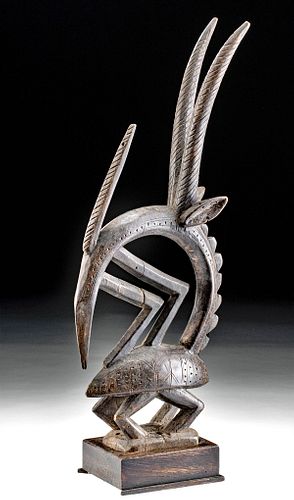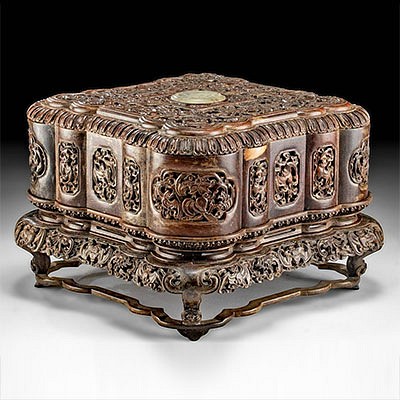Vintage Bamana Chi Wara Wood Antelope Headdress Carving
Lot 135
About Seller
Artemis Fine Arts
686 S Taylor Ave, Ste 106
Louisville, CO 80027
United States
Selling antiquities, ancient and ethnographic art online since 1993, Artemis Gallery specializes in Classical Antiquities (Egyptian, Greek, Roman, Near Eastern), Asian, Pre-Columbian, African / Tribal / Oceanographic art. Our extensive inventory includes pottery, stone, metal, wood, glass and textil...Read more
Estimate:
$1,600 - $2,500
Absentee vs Live bid
Two ways to bid:
- Leave a max absentee bid and the platform will bid on your behalf up to your maximum bid during the live auction.
- Bid live during the auction and your bids will be submitted real-time to the auctioneer.
Bid Increments
| Price | Bid Increment |
|---|---|
| $0 | $25 |
| $300 | $50 |
| $1,000 | $100 |
| $2,000 | $250 |
| $5,000 | $500 |
| $10,000 | $1,000 |
| $20,000 | $2,500 |
| $50,000 | $5,000 |
| $100,000 | $10,000 |
| $200,000 | $20,000 |
About Auction
By Artemis Fine Arts
Apr 8, 2021
Set Reminder
2021-04-08 10:00:00
2021-04-08 10:00:00
America/New_York
Bidsquare
Bidsquare : Fine Antiquities | Asian | Ethnographic Art
https://www.bidsquare.com/auctions/artemis-gallery/fine-antiquities-asian-ethnographic-art-6770
Features classical antiquities, ancient and ethnographic art from cultures encompassing the globe. Egyptian, Greek, Roman, Etruscan, Near Eastern, Asian, Pre-Columbian, Native American, African / Tribal, Oceanic, Spanish Colonial, Russian, Fine Art, so much more! All legally acquired, legal to sell. Artemis Fine Arts info@artemisgallery.com
Features classical antiquities, ancient and ethnographic art from cultures encompassing the globe. Egyptian, Greek, Roman, Etruscan, Near Eastern, Asian, Pre-Columbian, Native American, African / Tribal, Oceanic, Spanish Colonial, Russian, Fine Art, so much more! All legally acquired, legal to sell. Artemis Fine Arts info@artemisgallery.com
- Lot Description
West Africa, Mali, Bamana (also Bambara), ca. early to mid 20th century CE. A large and magnificent male Chi Wara (Ci Wara) mask, so skillfully and extensively carved with an intricate composition and marvelous incised embellishments. Often described as an antelope, the Chi Wara is actually a composite animal – part antelope, part aardvark, and part pangolin. All of these animals are creatures that dig up the earth; while antelopes carve the ground with their hooves, the aardvark and pangolin use their claws to excavate termite mounds. This communion with the earth makes them ideal components of the Chi Wara, the supernatural being believed to have taught the Bamana people how to farm. Size: 7.75" W x 18.75" H (19.7 cm x 47.6 cm); 20.625" H (52.4 cm) on included custom stand.
Historically, such masks were worn by male and female pairs in a dance performance that praised skilled farmers. The creator of this particular mask emphasized the broad neck and mane of the roan antelope. The vertical horns resemble those of both the roan and oryx antelopes. The body, with its pronounced ears and short legs, suggests the aardvark; while the incised surfaces suggest the scales of the pangolin. A bold and breathtaking mask that demonstrates a high level of skill with its expert carving and overall beautiful composition.
Another Chi Wara headdress mask realized $47,500 at Christies, New York, May 10, 2012, Sale 2661, Lot 20.
Provenance: private Houston, Texas, USA collection, purchased from Rand Smith at Rand Smith Tribal, Denver, Colorado, USA in 2013; ex Austrian collection
All items legal to buy/sell under U.S. Statute covering cultural patrimony Code 2600, CHAPTER 14, and are guaranteed to be as described or your money back.
A Certificate of Authenticity will accompany all winning bids.
We ship worldwide and handle all shipping in-house for your convenience.
#162791Repair to front angular element joining head to body (one piece reattached at the center). Stable fissure and nick to angular element behind it. Stable fissures to neck. Partial perforation to front horn. Perforations to ears for suspending ornaments; one of these perforations has a loss and no longer functions. Four intended perforations to integral base which is now attached to custom stand. Expected surface wear with scuffs, nicks, and abraded areas commensurate with age. One lower section of custom stand is missing, but the piece still stands in a balanced manner.Condition
- Shipping Info
-
All shipping is handled in-house for your convenience. Your invoice from Artemis Gallery will include shipping calculation instructions. If in doubt, please inquire BEFORE bidding for estimated shipping costs for individual items.
-
- Buyer's Premium



 EUR
EUR CAD
CAD AUD
AUD GBP
GBP MXN
MXN HKD
HKD CNY
CNY MYR
MYR SEK
SEK SGD
SGD CHF
CHF THB
THB













